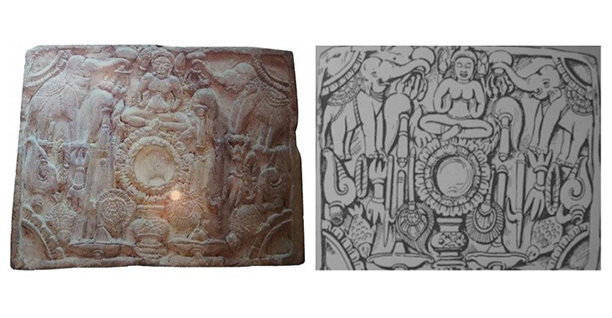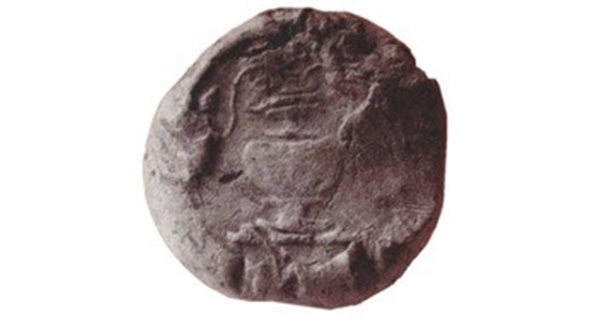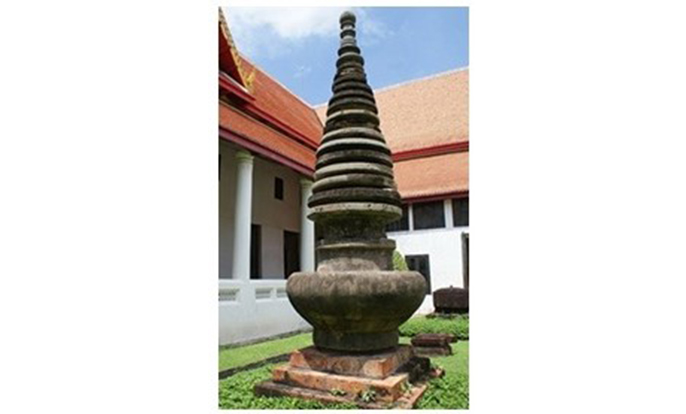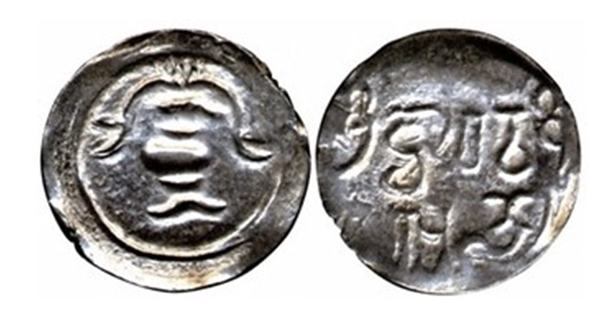People in the ancient times created a large amount of symbols from things around them in order to convey messages and to tell stories according to what they had witnessed. Living together as a community, ancient people used these symbols as common representations of beliefs and opinions of the people in the community. Such symbols might exist in either physical or abstract form. They come in various types, usually in the form of art which is embedded with deep and meaningful beliefs. Most of such art is related to religion and the monarchy.
Purna-Kalasha and Indian beliefs
Purna-Kalasha or Purna-Khata is a symbol created by ancient Indians to represent fertility and wealth. The word 'Purna' according to its Sanskrit root means fertility and wealth; 'Kalasha' means pot. With the two combined, the new term thus means ‘the pot of fertility’. It refers to full water vessel. There are vines rambling out of both sides of the pot, representing birth or creation. In both Buddhism and Brahmanism, Purna-Kalasha is regarded as a container of the holy water used in important rituals, such as Rajasuya ritual or the consecration of the king. It is called by various different names, such as, Kalasha, Purna-Kalasha, and Kamandalu. Indian people believe that Purna-Kalasha is the pot of the holy water retrieved from the occasion where the devas (gods) and asuras (demons) worked together for a millennium to churn the Kshirsagar ocean. The symbol is often found on religious art, for example, stone carvings at Sanji and Bharhut stupa, which are important place of worship in ancient India. The symbol was passed onto the land of Suvarnabhumi since Dvaravati period.

Stone carving of Lakshmi at Sanji and Bharhut stupa
Purna-Kalasha during Dvaravati period
Dvaravati refers to the kingdom located in Chao Phraya river basin, originally came into existence around 11th Buddhist Century Era. The name 'Dvaravati' as known in Thai was recorded in the travel memoir written by two Chinese monks Hiun Tsang and I-Tsing as 'Tolopoti'. The kingdom was located in between Si Kaset (Myanmar) and Isanpur (Khmer). According to the discovery of archaeological sites as well as items, it is assumed that the center of Dvaravati kingdom must have been located in the central region of Thailand; thereby sent its influence to surrounding regions.
Dvaravati was under monarchy rule. This is according to evidence found in the town of U-Thong, Suphanburi province, along with a bronze plate made in Dvaravati art that mentioned the name of King Hunsavraman. It is assumed that the name refers to a king of Dvaravati kingdom. Moreover, a coin made of silver has been found in Phra Prathon subdistrict, Nakhon Prathom province. On it is written ‘Sri Dvaravati Svrapunya’, in Sanskrit using Palawa characters, which translates ‘the royal merits of the King of Dvaravati’. This kingdom has been passed on cultural and religious beliefs from India, via Indian merchants and the propagation of religion. The majority of the population subscribed to Buddhism and Brahmanism.
The symbol of Purna-Kalasha from Dvaravati period is found on religious art. It appears on a face of a silver coin, a seal, and a piece of stone marker. Additionally, Purna-Kalasha has also been found in combination with other auspicious symbols with an influence of Indian culture. These symbols include a trishula, a conch, a dharmachakra, twin fish, swastika, and a lotus flower. They are collectively called Astamangala or the collection of eight lucky things. These symbols are found as decorations on artworks that were created for a religious purposes or pertained relation to the king. Evidence of the use of Purna-Kalasha during Dvaravati period appears in art form as the following:
1. Purna-Kalasha in sculpture
- Image of Kasha-Lakshmi made with baked clay It was found at Phra Pathom Chedi in Nakhon Pathom province. The symbol of Purna-Kalasha on the image represents the ceremony to elevate the status of the king to that of the deity, namely Rajasuya ceremony or the coronation ceremony of the ancient Indian king. The image appears on a terracotta plate. The centre is surrounded by two rings of lotus petals. The top tier is the image of the goddess Lakshmi and elephants; further down is that of a whip, an elephant hook, a royal long handled fan, a royal umbrella, twin fish and a pair of conches, with a Purna-Kalasha at the bottom. There is an image of a one-sided lotus on all four corners of the images. It is assumed that they were meant to support the vessel which will be used for the bath of the gods and goddesses during the coronation ceremony of the king of Dvaravati.

Image of Kasha-Lakshmi made with baked clay was found at Phra Pathom Chedi in Nakhon Pathom province
- The symbol of Purna-Kalasha on a terracotta boundary marker It was found in the north-eastern area. The symbol of the vessel in the image is in a high cone shape. In Dvaravati culture, boundary markers were made specially to mark the locations that bear significance in Buddhism. The symbol of Purna-Kalasha found on the marker is assumed to be one of the offerings used in religious ceremonies, probably a part of rice offering set, which also represents fertility.
A terracotta boundary marker with Purna-Kalasha symbol at Sri Dhammaram temple, Muang district, Yasothon province
- The symbol of Purna-Kalasha on seals from Dvaravati period that were found from port towns and other important cities. They are assumed to have belonged to merchants who carried them as a charm, for good luck and prosperity.
Purna-Kalasha seal
2. Purna-Kalasha in architecture
During Dvaravati period, it is common to build stupas as a dedication to Buddhist religion. These stupas were built in the form of Purna-Kalasha to represent richness, namely religious prosperity.
A stupa in Purna-Kalasha shape in 7 AD century
3. Purna-Kalasha on Dvaravati coins
Coins that have been found to have been from Dvaravati period in Thailand had been produced locally. This can be known because the names of kings and the city appearedon the coin. Generally, silver coins from this period are 1.7-3 centimetres in diameter. The symbol of Purna-Kalasha that appears on Dvaravati mint coins are of two designs:
3.1 Purna-Kalasha symbol - an inscription using Pallawa character The front is the Purna-Kalasha symbol to represent prosperity; the back is the inscription in Pallawa characters, written, 'Sri Dvaravati Svrapunya, which translates ‘the royal merits of the King of Dvaravati’. This is an important evidence to confirm a relation to Dvaravati kingdom which was under the rule of monarchy. It is believed to have been made according to the Buddhist belief.
Purna-Kalasha symbol - an inscription using Pallawa character on a Dvaravati coin
3.2 Purna-Kalasha symbol - Srivatsa symbol The front of the coin is the symbol of Purna-Kalasha; the back is the Srivatsa symbol to represent the kingdom's wealth and prosperity. Within the Srivatsa symbol is a symbol of two Vajras which are Indra's weapon and represent the mighty power of the king. Above Srivatsa symbol is a symbol of the sun and the waning moon which represent the sky or the cosmos. On the left and the right was a symbol of a godly weapon, namely a sceotre or an elephant hook. At the bottom of the Srivatsa symbol is an image of a fish, which is also a symbol representing fertility.
Purna-Kalasha symbol - Srivatsa symbol on a Dvaravati coin
Silver coins were considered the symbol that Dvaravati was thriving as a city. They showed the liveliness of international trade. Furthermore, that the coins were found in different locations is a good indication of the boundary of the Dvaravati kingdom.
According to the above evidence, it can be concluded that in Dvaravati culture, Purna-Kalasha was an auspicious symbol of richness, wealth, birth, and creation. Such belief derived from the belief in Buddhism and Brahmanism brought to the Suvarnabhumi region by Indian merchants. The evidence to this appears in different forms of religious arts. Furthermore, the symbol was also used in combination with other auspicious symbols to convey the beliefs behind ceremonial gestures; in other words to convey the power and status of kings in Dvaravati period.







